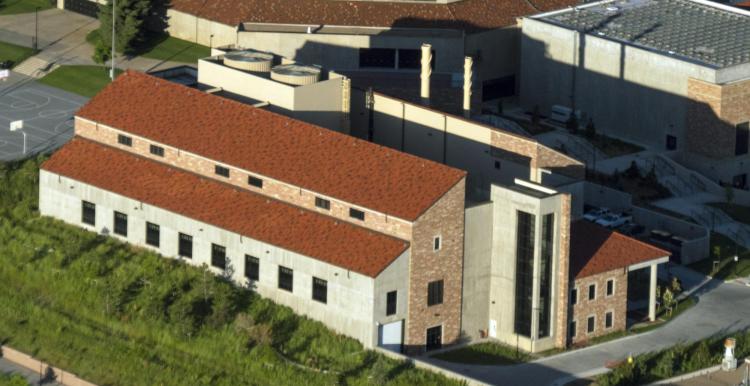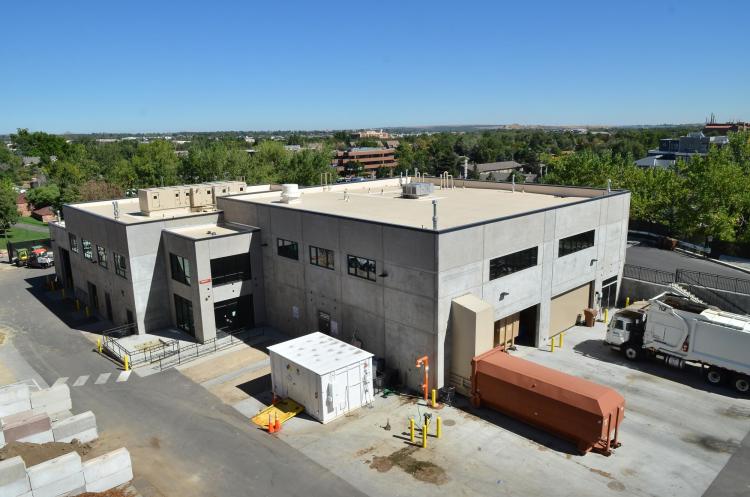3 campus buildings receive LEED Gold certifications for sustainability
Three CU Boulder buildings where missions center largely on sustainability all recently garnered recognition from the United States Green Building Council for the sustainable ways in which they were built and operate.
The Sustainability, Energy and Environment Laboratory (SEEL) on East Campus and the East District Energy Plant (EDEP) and Grounds and Recycling Operations Center (GROC) on Main Campus have been granted LEED Gold certifications. The latest certifications bring to 22 the total number of CU Boulder buildings certified LEED Gold or better, either for new construction or major renovations.
LEED, or Leadership in Energy and Environmental Design, is a globally recognized symbol of excellence in green building, with certification ensuring electricity cost savings, lower carbon emissions and healthy work environments. There are four levels of certification, with Platinum being the highest, followed by Gold, Silver and Certified.
CU Boulder has long been a leader in its pursuit of LEED certification for campus buildings, one of the many ways the university strives to be a model of sustainable practices,” said Heidi VanGenderen, chief sustainability officer at CU Boulder. “These three latest certifications illustrate our commitment to creating lasting buildings that are both environmentally friendly and go above and beyond in serving the needs of our campus community.”

The East District Energy Plant opened in 2014, and generates the steam production that provides heating and cooling for much of the campus.
CU Boulder students helped drive the university’s push toward LEED-certified construction in the early 2000s, and the campus now aims for LEED Gold or better on every major capital construction project, with the particular emphasis on energy and water efficiency as outlined in the Campus Master Plan. CU Boulder’s LEED-certified building roster includes seven LEED Platinum buildings, with the most recent being the Student Recreation Center. The Williams Village North residence hall, when it was built, was the largest LEED Platinum residence hall in the country.
CU’s latest LEED-certified buildings all carry the campus sustainability torch on an everyday basis. The Sustainability, Energy and Environment Community (SEEC) is a hub for environmental and sustainability research, and the new SEEL building that opened in 2015 provides wet lab space to support those endeavors.
Opened in 2014, the EDEP building generates the steam production that provides heating and cooling for much of the campus, and also serves as the headquarters for CU Boulder’s Utility and Energy Services division.
The GROC building, meanwhile, opened in 2015 and houses both the outdoor services and waste management teams, as well as integrated pest management. It is home to the campus recycling center, where student workers process recyclables collected from around campus.
Highlights from each of the three buildings that helped them attain LEED Gold status include:

The Grounds and Recycling Operations Center opened in 2015, and houses both the outdoor services and waste management teams, as well as integrated pest management.
Sustainability, Energy and Environment Laboratory (SEEL)
The signature feature of SEEL is a high-performance energy recovery system that captures waste exhaust from labs and utilizes it in the heating and cooling of the building.
The building also includes a chilled water loop that enables localized cooling of lab equipment, drastically reducing water use in the building. Labs in the building, meanwhile, were created to be flexible in the equipment and systems provided so they can be tailored to individual researchers’ needs over time without major renovations.
East District Energy Plant (EDEP)
All stormwater from the roof of the building is captured and released into a pair of rain gardens on the east side of the building where the water can gradually soak into the ground. In extreme weather events, excess stormwater flows into underground chambers that hold the water and release it slowly to help prevent storm sewers from becoming overwhelmed.
Other sustainability features for the building include LED lighting that not only provides beautiful light in the 36-foot-high bays that house the boilers and chillers but also utilizes motion sensors to power on and off. Yellow exterior lighting at the roof level, meanwhile, helps reduce light pollution, a particularly important feature for campus given the building sits within the sightline of the Sommers-Bausch Observatory.
Grounds and Recycling Operations Center (GROC)
The GROC’s sustainable building features include an 11-kilowatt rooftop solar array, exterior LED lighting and an electric-truck charging station. The solar array is complemented by light-colored roofing material that maximizes reflectivity to help mitigate the urban heat island effect. Finally, when the building was built, crews managed to divert 97.8 percent of construction waste from the landfill.
Editor's note: This story was corrected to reflect the accurate number of buildings certified LEED Gold or better on the CU Boulder campus at the time this story was published.
Want more stories like this in your inbox? Sign up for the CU Boulder Today community edition.


